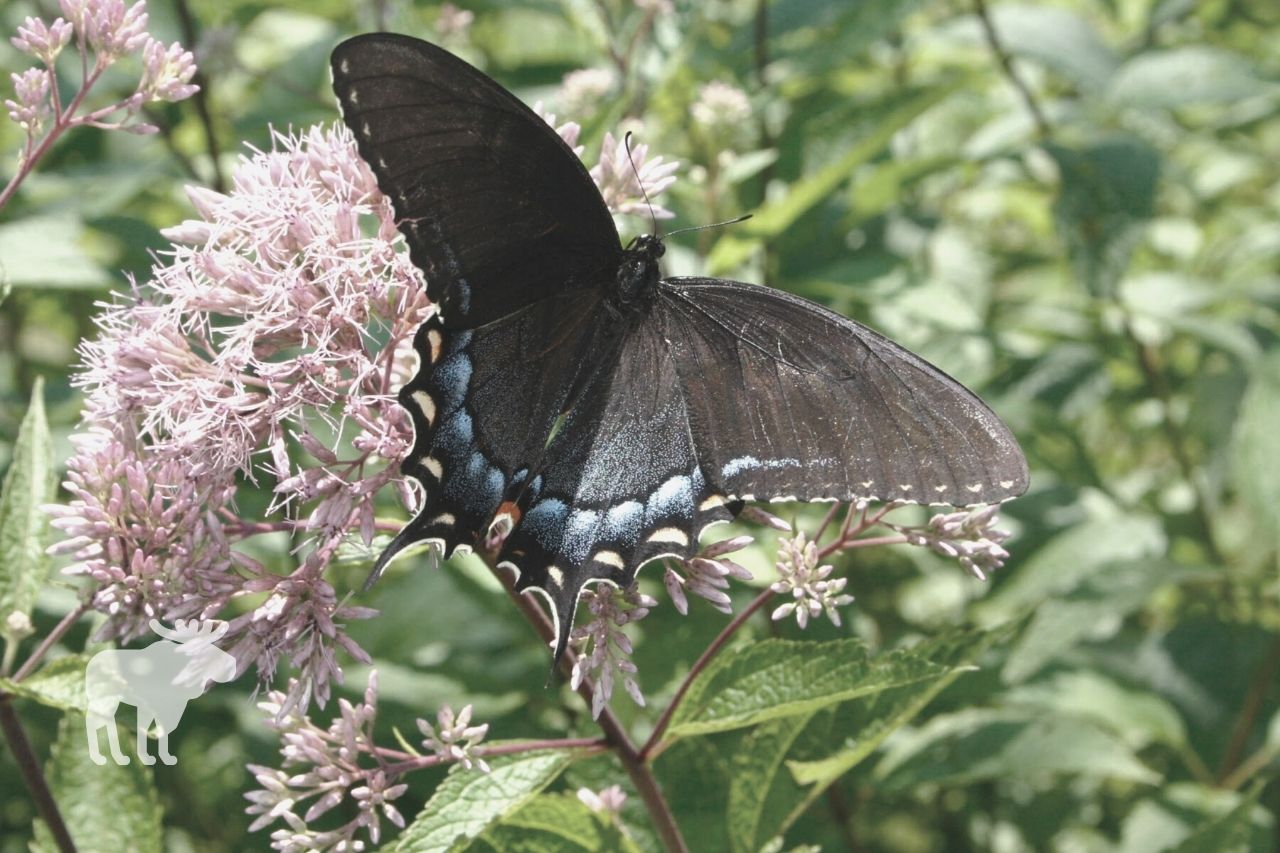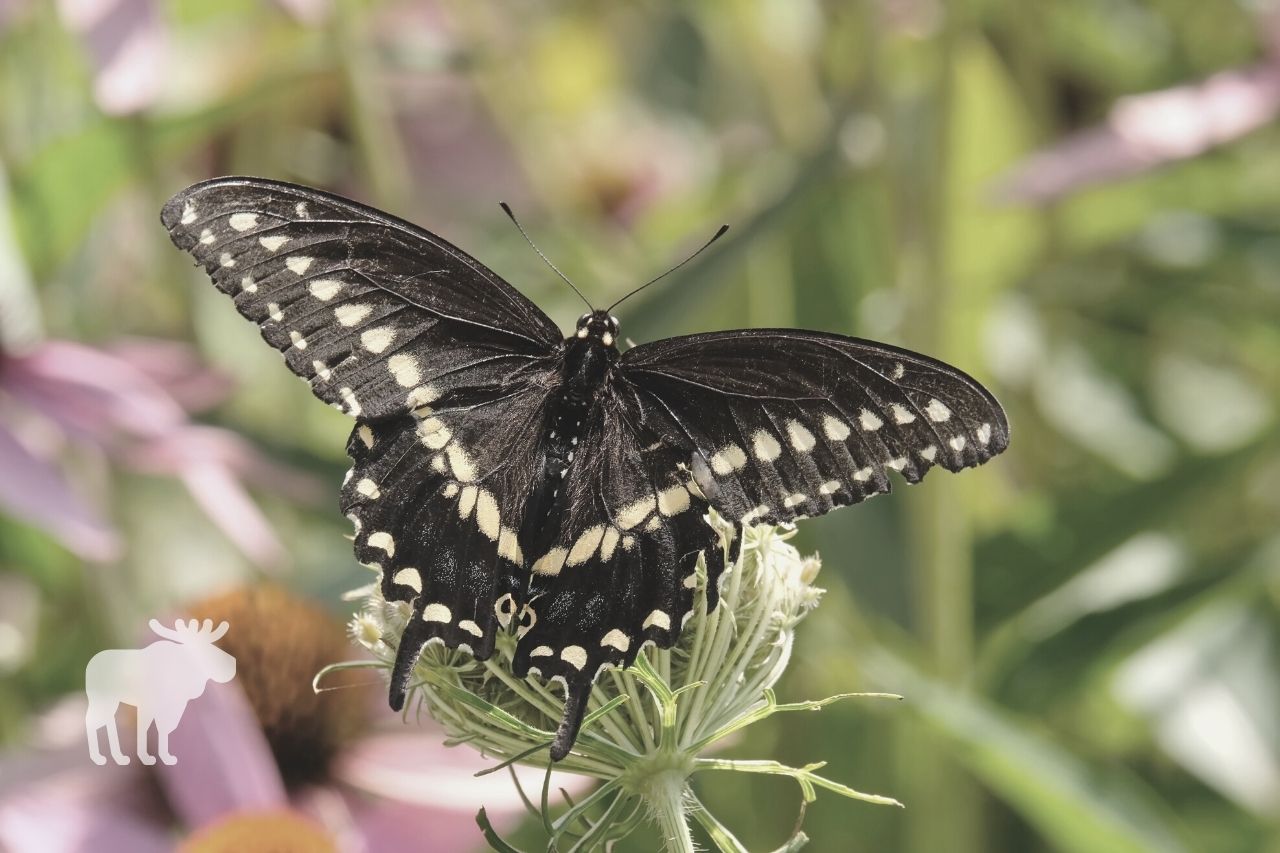Tiger swallowtails are usually quite easy to distinguish from other butterflies; but did you know that some of them are black instead of their classic yellow coloring? In this article, we’ll talk about how to tell the difference between black and tiger swallowtails, especially when you’re comparing a black tiger to a regular black swallowtail.
What You'll Learn Today
What is a Tiger Swallowtail?

Tiger swallowtails belong to the Papilio genus of butterflies. There are four different species in this genus, all of which look remarkably alike but are found in different regions of North America.
Most tiger swallowtails are pale to bright yellow in color, with black stripes on their wings and bodies. Females are larger than males and have a swath of blue across the bottom of their lower wings; both males and females have small orange markings on their wings as well.
Interestingly, some tiger swallowtail females have a genetic mutation that replaces their yellow coloring with black. These butterflies, called dark form tiger swallowtails, are all black, sometimes with noticeable darker black stripes, and blue swaths along the lower parts of their wings; they may also have pale yellow spots along the edges of their wings.
Tiger swallowtails are one of the largest butterflies in North America, as their wingspan can grow as wide as five inches. They are a common sight throughout the United States, Canada, and even parts of Mexico.
Tiger swallowtail caterpillars eat a variety of host plants depending on what’s available in their region; some eat the leaves of tulip trees and magnolias, others eat wild cherry and rose, still others eat cottonwood, aspen, and willow.
What is a Black Swallowtail?
Black swallowtails belong to the same genus as tiger swallowtails, Papilio. They are found widespread throughout many areas of North America, and their territories often overlap with those of tiger swallowtails.
Black swallowtails have almost the same coloring as tiger swallowtails, but the patterns on their body and wings are much different. As the name suggests, black swallowtails are mostly black; they have rows of horizontal yellow spots on their wings and vertical yellow spots on their bodies.
Both male and female black swallowtails may have swaths of blue along their bottom wings, though this blue marking is more prominent in females. Both male and females have a noticeable orange eye-like spot on each of their lower wings.
Black swallowtails are generally smaller than tiger swallowtails, though they are still fairly large with a wingspan up to 4 inches. Females are typically larger than males.
Black swallowtails are sometimes called parsley swallowtails because their caterpillars mostly eat plants in the parsley family. Some of these plants include parsley, carrot greens, and Queen Anne’s lace.
Do Black Swallowtails Look Like Tiger Swallowtails?

As noted above, black and tiger swallowtails have similar coloring but very different wing and body patterns. Tiger swallowtails tend to be more yellow in color, with black, blue, and orange markings; black swallowtails are more black in color, with yellow, blue, and orange markings.
That said, to the casual observer, dark form tiger swallowtails may look very similar to black swallowtails because they are primarily black, and their darker black stripes may or may not be visible.
You can clearly see the similarity of appearance in the side by side pictures here.
Black Vs. Tiger Swallowtail: How to Tell the Difference
So, how can you tell whether that butterfly you saw nectaring in your flower garden was a black swallowtail or a dark form tiger swallowtail? Fortunately, there are several ways to tell these two butterflies apart.
- Body patterns: Black swallowtails have rows of yellow spots extending down the length of their bodies. Yellow tiger swallowtails have black and yellow stripes down the length of their bodies, but dark form tigers have no bodily markings at all–they are solid black.
- Yellow wing spots: Black swallowtails have horizontal rows of yellow markings extending across their wingspan; these markings are generally brighter in males than in females. Dark form tiger swallowtails have a single row of pale yellow spots extending down the outer edge of each wing.
- Size: Dark form tiger swallowtails are always female, and they grow larger than both male tiger swallowtails and both male and female black swallowtails–up to five inches wide. Even if you can’t make out anything about a butterfly’s wing or body markings, you may be able to guess whether it is a black or a tiger based upon how large it is.
- Favorite plants: Both black and tiger swallowtails enjoy nectaring from a lot of different flowers, though blacks seem to have a particular love for clover. That said, they choose very different plants for laying their eggs.
If you see a black butterfly flitting around a tulip, magnolia, wild cherry, or willow tree, chances are, it’s a dark form tiger swallowtail. On the other hand, if you see one flitting around Queen Anne’s lace or the carrots in your garden, it’s probably a black swallowtail.
- Eggs and caterpillars: If you happen to catch the butterfly in question laying eggs, take a look at the eggs after it has moved on. Black swallowtail eggs will tend to be white to yellow in color and found on plants in the carrot family; tiger swallowtail eggs are more green in color and will be found on the leaves of various trees.
The caterpillars also look quite different; both appear as brown or black and white bird droppings when they are young, but as they grow, black swallowtail caterpillars become green with rows of orange, yellow, and black spots wrapping horizontally around their bodies. Tiger swallowtail caterpillars become solid green or brown in color with two distinctive eye-shaped markings on their neck.
Familiarizing yourself with each type of butterfly will also help you tell them apart. To help you become familiar with each type of butterfly, check out the following videos:
Conclusion
Black and tiger swallowtails are usually pretty easy to tell apart, but some female tigers have a genetic mutation that turns them black, making them much easier to confuse with black swallowtails.
That said, there are many ways to tell blacks and black tigers apart, including distinctive markings on their wings and bodies, their relative size, the plants they prefer, and the appearance of their eggs and caterpillars.
Thank you! This post was grand since it is organized, has JUST enough info to help a n “armchair” naturalist, and uses photos at just the right places. I was trying to identify a swallowtail caterpillar. You gave me the right info to know it is (almost surely) a black swallowtail. If the chrysalis confirms that one the adult emerges, I will try to come back and tell the readers! (Summer, 2022)
(I didn’t catch a typographical mistake: I meant to type “once the adult emerges”.)
Paplilio rutulus, bound to be one of the largest, most impressive Swallowtail to visit Northcoast gardens to orchards, their Native forests, mountain meadow or glades, and the high country of various mountain ranges within their range. Robust, favoring flowers with its probing tongue being a major pollinating agent for these outlying ecosystems. Possibly infamous for its Latin roots, Butterfly, as an Individual would have a name, this became a modern Genus of Butterflies! Having observed their Species favoring pine saps, frequenting ash piles, salt licks or alkaline salts, and generally aloof from it all, being so stately. Certainly Native in Southern Oregon and Northern California! They are, vulnerable however, so using or supporting Organic or transitional methods of “Pest” control should be reviewed or supported as Farming Techniques. Welcome to correspond as inspiring pollinators need protection from pesticide misuses, and this native Species hopes to evolve naturally.